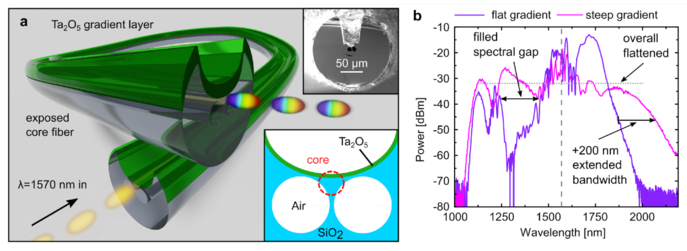Spectral light sources are one of the key basic modules of all upcoming advanced optical technology. High demands are made by different applications in fundamental science, medical diagnostics and environmental screening with independently different requirements in terms of spectral range and uniformity, stability and intensity.
 (a) Illustration of the nano-film enhanced exposed core fiber. The top inset is a scanning electron micrograph image of the cross-section of the fiber and the bottom inset shows the schematic cross-section of the core region. A red dashed circle marks the core. (b) Improvement of the measured spectral output of a fiber having a steep nano-film gradient of ∼1.1 nm/mm (59-144 nm thickness, 68 mm fiber length, pink) compared to one with almost uniform nano-film thickness (62-70 nm thickness, 70 mm fiber length, purple) and similar starting thicknesses. The central pump wavelength is indicated by the vertical dashed line. (Image Credit: Tilman Lühder, Henrik Schneidewind, Erik Schartner, Heike Ebendorff-Heidepriem, and Markus A. Schmidt).
(a) Illustration of the nano-film enhanced exposed core fiber. The top inset is a scanning electron micrograph image of the cross-section of the fiber and the bottom inset shows the schematic cross-section of the core region. A red dashed circle marks the core. (b) Improvement of the measured spectral output of a fiber having a steep nano-film gradient of ∼1.1 nm/mm (59-144 nm thickness, 68 mm fiber length, pink) compared to one with almost uniform nano-film thickness (62-70 nm thickness, 70 mm fiber length, purple) and similar starting thicknesses. The central pump wavelength is indicated by the vertical dashed line. (Image Credit: Tilman Lühder, Henrik Schneidewind, Erik Schartner, Heike Ebendorff-Heidepriem, and Markus A. Schmidt).
For instance, optical coherence tomography requires a flat spectrum to guarantee high-resolution scans of the human retina. Moreover, field application hand-held spectroscopy prefers lightweight solutions with minimal energy supply.
Since fiber-based supercontinuum sources are a favorable technology to develop broadband light from a single laser, comprehensive investigation and optimization of this nonlinear frequency conversion process with unconventional approaches are essential.
Researchers from the Leibniz Institute of Photonic Technology (Leibniz IPHT) in Jena, Germany, headed by Professor Markus A. Schmidt in partnership with the University of Adelaide, Adelaide, Australia, suggest a unique concept to enhance supercontinuum light sources in a new paper published in Light Advanced Manufacturing.
The key of their research is including precisely deposited nano-films within microstructured fibers. Nano-films can be incorporated through sputtering via an open channel in the fiber directly on the optical core.
“Having the freedom to arbitrarily tailor the nano-film thickness along the whole fiber length leads to interesting physics” the researchers state. “Especially thickness increasing nano-film gradients by tilting the fiber in the deposition chamber has proven to be useful.”
These gradients alter the nonlinear frequency conversion condition at various positions in the fiber to form light at many different wavelengths and cover a wide and flattened output spectrum. This allows for the formation of wide and flat spectra at low input energy.
The researchers add: “Low input energy in combination with avoiding higher-order soliton fission and modulation instability ensures high coherence and an excellent pulse to pulse stability, which, for example, is relevant for optical frequency metrology.”
Furthermore, the bandwidth is stretched toward the infrared compared to stable thickness nano-film optimized fibers.
“It is like the Raman shifting soliton surfing on the wave of changing dispersion towards longer wavelengths” they clearly elucidate.
Their generic idea of including longitudinally differing optical resonances into waveguides is not restricted to fibers and can be used in a versatile manner with a variety of high index materials, such as chalcogenides, metal oxides and semiconductors.
“This shifts the production challenge for new tailored light sources from drawing precise fibers to depositing layers, which is more widely available around the world” they concluded.
Journal Reference:
Lühder, T.A, M., et al. (2021) Longitudinally thickness-controlled nanofilms on exposed core fibres enabling spectrally flattened supercontinuum generation. Light Advanced Manufacturing. doi.org/10.37188/lam.2021.021.